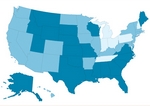Government
Many states widened health coverage in 2008
■ But the worsened economy could slow state reform efforts.
By Doug Trapp — Posted Feb. 20, 2009
- WITH THIS STORY:
- » Related content
Washington -- Despite enduring an economic downturn, many states in 2008 continued to reform their health care delivery systems and attempt to provide better access, according to a survey released Feb. 4.
Last year, 10 states adopted laws to expand children's health coverage, a few states tried and failed to enact universal health coverage legislation, and others made more incremental improvements. The 64-page survey of state efforts was conducted by the State Coverage Initiatives program, a project funded by the Robert Wood Johnson Foundation and administered by Academy Health, a policy research group.
California, Pennsylvania and New Mexico all considered but failed to adopt universal coverage legislation. Massachusetts remains the lone state attempting to cover nearly all of its residents. It had the lowest percentage of uninsured in the country at 7.9% in 2006-07, the Census Bureau said.
Iowa and New Jersey made significant moves in 2008, the report said. Iowa lawmakers created a council to develop a five-year road map to universal coverage, while New Jersey adopted a mandate -- albeit without penalties -- for all children to have health insurance. Both expanded the Children's Health Insurance Program eligibility as well.
Other states, such as Florida, sought to make private insurance more accessible by making it more affordable. The state's Cover Florida program contracts with private insurers to offer affordable basic health plans. In January, the program began offering 25 different basic health plans, 14 of which have average monthly premiums of about $150 or less.
But state budget shortfalls and the potential for federal reform are likely to dampen state reform efforts in 2009, the report concludes.
The study is available online (link).












